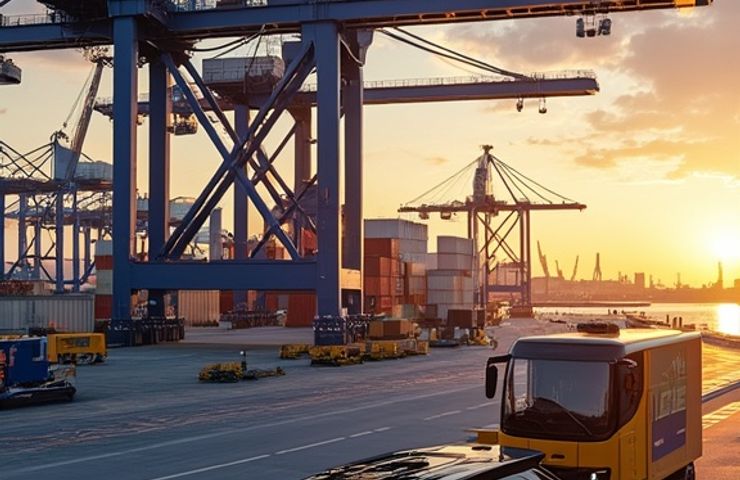
Hydrogen-Powered Straddle Carrier Revolutionizes Port Logistics in Hamburg
October 1, 2025It’s not every day you see a port take a giant leap toward cutting its carbon footprint, but that’s exactly what happened in Hamburg on 29 September 2025. HHLA rolled out the first operational hydrogen-powered straddle carrier at its Container Terminal Tollerort (CTT). No gimmicks here—this is a real-world solution built to tackle heavy-load handling head-on and designed with tomorrow in mind.
HHLA’s Journey Toward Climate Neutrality
Founded in 1885, Hamburger Hafen und Logistik AG (HHLA) has grown into one of Europe’s port logistics powerhouses, operating terminals in Hamburg and beyond. With a bold target of climate neutrality by 2040, they’ve funneled resources into digital upgrades and decarbonization R&D. Since 2020, hydrogen-driven projects have been taking center stage, culminating in the Clean Port & Logistics cluster—a network of more than 40 partners backed by the Federal Ministry for Digital and Transport (BMVI). The aim? Send carbon emissions packing.
Why Hydrogen? A Real-World Solution for Heavy Lifting
Batteries have come a long way, but for equipment that hauls dozens of containers every hour, battery weight, charging stops, and limited range can be absolute deal-breakers. That’s where hydrogen fuel cells shine. A quick top-up at a hydrogen refueling station and these carriers can run full shifts without lugging around massive battery packs. And the cherry on top? The only tailpipe emission here is water vapor—a genuine win for air quality and uptime.
From Concept to Container: How the Test Works
CTT’s testing ground isn’t just a parking lot; it’s a mini hydrogen hub. The carrier pulls up to a high-pressure dispenser that fills the tanks—picture a diesel pump but much cleaner. Onboard, the fuel cell turns hydrogen into electricity for the electric motors. They kicked things off with a single Konecranes model, but the infrastructure is already set up to support more straddle carriers, forklifts, and even regional hydrogen trucks soon.
Performance Highlights and Efficiency Insights
Dock operators report that the hydrogen-powered straddle carrier handles just like its diesel-hybrid siblings—no drop in speed, no loss of agility. Early feedback from HHLA and Konecranes suggests efficiency on par with the best hybrid machines, although independent long-term studies are still pending. For now, uptime and reliability are what matter most—and so far, the demo isn’t missing a beat.
Stakeholder Collaboration: The CPL Network in Action
The secret behind this trial is the Clean Port & Logistics cluster. Beyond HHLA and Konecranes, the network brings together equipment makers, energy suppliers, research institutes, and government bodies. They share insights, standardize safety protocols, and test cost-sharing models. Thanks to a €3 million investment from the BMVI, this public-private partnership is laying down a roadmap for port logistics decarbonization that others can follow.
The BMVI’s Vision: Funding the Future
Germany’s National Hydrogen Strategy aims to make the country a green hydrogen frontrunner by 2030. That €3 million boost for the Hamburg pilot isn’t random—it’s part of the EU’s Fit for 55 plan to slash emissions by 55% this decade. By backing real-world pilots, policy-makers hope to accelerate validation, attract investors, and iron out regulatory wrinkles. When government and industry team up, the road to commercialization gets a whole lot smoother.
Regulatory and Market Context
Ports are under growing pressure: tougher EU emissions standards, stricter local air quality laws, and community demands for cleaner operations. At the same time, green hydrogen costs are dropping thanks to scale-ups and technology advances. This trial catches that wave, setting a precedent that could shape future regulations on port equipment emissions and safety not just in Germany, but across Europe and beyond.
Training, Safety, and Operational Readiness
Hydrogen might be uncharted territory for many dock crews, so the CPL partners run regular training sessions on safe handling, refueling procedures, and emergency response. Whether you’re a stevedore, engineer, or technician, you’ll come away fluent in hydrogen safety—an absolute must when you’re filling tanks at thousands of PSI.
Wider Impact: Lessons Beyond the Port
This demo doesn’t stop at container terminals. The insights from CTT could easily migrate to airport ground support vehicles, heavy construction machinery, and regional haul fleets. Once a hydrogen refueling station is in place, it makes sense to fuel a wider range of high-utilization equipment. The real kicker? It could ignite entire hydrogen ecosystems in port cities, spawning fresh business models for clean fuel distribution and maintenance.
Scaling Up: From Trial to Transformation
HHLA plans to roll out more carriers and expand the refueling setup to serve everything from terminal trucks to hinterland delivery vans. Data and best practices will be packaged into easy-to-follow guides, making it simpler for other ports to jump on the green hydrogen bandwagon. The momentum is building—this pilot might be the blueprint the industry’s been waiting for.
Challenges on the Horizon
Hydrogen’s got plenty of buzz, but let’s be real: building green hydrogen plants, securing a reliable supply, and covering upfront investments are no small feats. Clear regulations on hydrogen standards and cross-border refueling networks will be essential. Still, with BMVI support and the collaborative spirit of Clean Port & Logistics, these hurdles look more like stepping stones than roadblocks.
Bottom line, HHLA and its partners aren’t just talking up HHLA sustainability or port logistics decarbonization—they’re making it happen. This hydrogen-powered straddle carrier trial is a hearty challenge thrown at traditional diesel fleets. As ports worldwide grapple with climate targets and air quality demands, Hamburg’s CTT demo proves hydrogen can deliver performance, reliability, and environmental benefits all in one package. Stay tuned—this is just the beginning of zero-emission port equipment.



 With over 15 years of reporting hydrogen news, we are your premier source for the latest updates and insights in hydrogen and renewable energy.
With over 15 years of reporting hydrogen news, we are your premier source for the latest updates and insights in hydrogen and renewable energy.